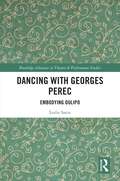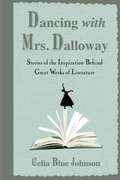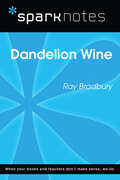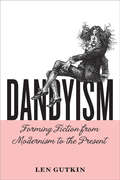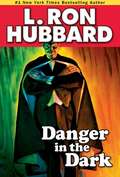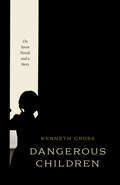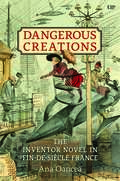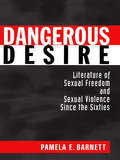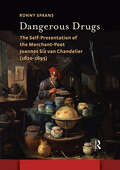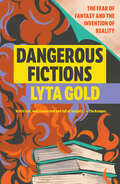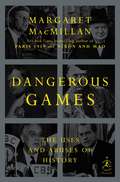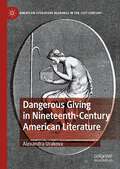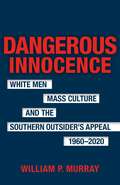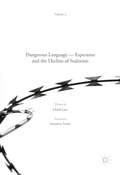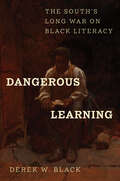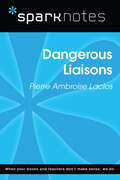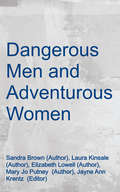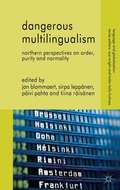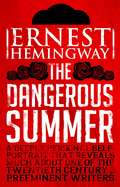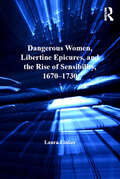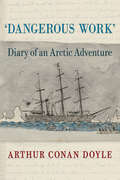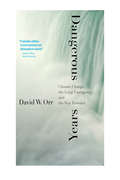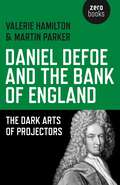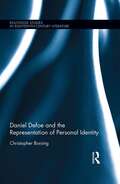- Table View
- List View
Dancing with Georges Perec: Embodying Oulipo (ISSN)
by Leslie SatinThis book explores the relationship of the life and work of the remarkable Parisian-Jewish writer Georges Perec (1936–1983) to dance."Dancing" addresses art-making parallels and their personal and sociocultural contexts, including Perec’s childhood loss of his parents in the Holocaust and its repercussions in the significance of the body, everydayness, space, and attention permeating his work. This book, emerging from the author Leslie Satin’s perspective as a dancer and scholar, links Perec’s concerns with those of dance and demonstrates that Perec’s work has implications for dance and how we think about it. Moreover, it is framed as a performative autobiographical enactment of the author's relationship to Perec, periodically linking their written, danced, and imagined lives.This exploration will be of great interest to dancers, dance scholars, and dance students interested in contemporary experimental dance and contemporary dance.
Dancing with Mrs. Dalloway
by Celia Blue JohnsonThe Real Stories Behind Everyone's Favorite Novels-from The Wonderful Wizard of Oz to The Great Gatsby. Every great book begins with an idea, whether it comes to a writer's mind with lightning speed or tugs at the imagination over time. Dancing with Mrs. Dalloway offers stories of the inspiration behind fifty classic works, from The Sound and the Fury, Jane Eyre, and Frankenstein to Anna Karenina, The Bell Jar, and Winnie-the-Pooh.Gabriel García Márquez was driving to Acapulco with his family when he slammed on the brakes, turned the car around, and insisted they abandon their trip so he could return home to write. He had good reason to cut the trip short-a childhood memory of touching ice had suddenly sparked the first line to a novel that would become his most famous work, One Hundred Years of Solitude.C. S. Lewis, on the other hand, spent decades pondering the scene that inspired The Lion, the Witch and the Wardrobe. When Lewis was sixteen, he had a peculiar daydream: a faun carried a bundle of parcels and an umbrella through snow-covered woods. Lewis was almost forty when he decided to write a novel that grew around the vision.In Dancing with Mrs. Dalloway, you'll discover who Edgar Allan Poe's raven really belonged to, whether Jane Austen's heartthrob Mr. Darcy actually existed, who got into mischief with a young Mark Twain, and what the real Sherlock Holmes did for a living. These delightful stories reveal the often unknown reasons our literary heroes put quill to parchment, pen to paper, or finger to keyboard to write some of the world's best-loved books.
Dandelion Wine (SparkNotes Literature Guide Series)
by SparkNotesDandelion Wine (SparkNotes Literature Guide) by Ray Bradbury Making the reading experience fun! Created by Harvard students for students everywhere, SparkNotes is a new breed of study guide: smarter, better, faster.Geared to what today's students need to know, SparkNotes provides:chapter-by-chapter analysis explanations of key themes, motifs, and symbols a review quiz and essay topics Lively and accessible, these guides are perfect for late-night studying and writing papers.
Dandyism: Forming Fiction from Modernism to the Present (Cultural Frames, Framing Culture)
by Len GutkinThe "dandy," a nineteenth-century character and concept exemplified in such works as Wilde’s The Picture of Dorian Gray, reverberates in surprising corners of twentieth- and twenty-first-century culture. Establishing this character as a kind of shorthand for a diverse range of traits and tendencies, including gentlemanliness, rebelliousness, androgyny, aristocratic pretension, theatricality, and extravagance, Len Gutkin traces Victorian aesthetic precedents in the work of the modernist avant-garde, the noir novel, Beatnik experimentalism, and the postmodern thriller. As defined in the period between the fin de siècle and modernism, dandyism was inextricable from representations of queerness. But, rinsed of its suspect associations with the effeminate, dandyism would exert influence over such macho authors as Hemingway and Chandler, who harnessed its decadent energy. Dandyism, Gutkin argues, is a species of gendered charisma. The performative masquerade of Wilde’s decadent dandy is an ancestor to both the gender performance at work in American cowboy lore and the precious self-presentation of twenty-first-century hipsters. We cannot understand modernism and postmodernism’s negotiation of gender, aesthetic abstraction, or the culture of celebrity without the dandy. Analyzing the characteristic focus on costume, consumption, and the well-turned phrase in readings of figures ranging from Wyndham Lewis, Djuna Barnes, and William Burroughs to Patricia Highsmith, Bret Easton Ellis, and Ben Lerner, Dandyism reveals the Victorian dandy’s legacy across the twentieth century, providing a revisionist history of the relationship between Victorian aesthetics and twentieth-century literature.
Danger in the Dark
by L. Ron HubbardExplore this fantastic tale. After Billy Newman strikes gold while mining in the Philippines, he believes Lady Luck favors him so much that he buys his own South Seas island for a bargain price . . . or so he thinks. But when the natives fall ill from plague and crops start failing, the tribal chiefs blame Billy for angering the local god Tadamona. Their solution: sacrifice a beautiful young girl before the 75-foot god. Appalled, Billy argues to stop the ritual, but the chiefs demand he cure their ills in just one day or allow the killing to go forward. Desperate, he denies that the deity even exists and dares Tadamona to show himself. Not only does Billy get his wish, he draws a beastly wrath upon the entire island. ALSO INCLUDES THE FANTASY FICTION STORIES "THE ROOM" AND "HE DIDN'T LIKE CATS" "Pulp fiction devotees need to put Hubbard's works on their must-read lists." --Booklist
Dangerous Children: On Seven Novels and a Story
by Kenneth GrossGross explores our complex fascination with uncanny children in works of fiction. Ranging from Victorian to modern works—Lewis Carroll’s Alice in Wonderland, Carlo Collodi’s Pinocchio, Henry James’s What Maisie Knew, J. M. Barrie’s Peter and Wendy, Franz Kafka’s “The Cares of a Family Man,” Richard Hughes’s A High Wind in Jamaica, Elizabeth Bowen’s The Death of the Heart, and Vladimir Nabokov’s Lolita—Kenneth Gross’s book delves into stories that center around the figure of a strange and dangerous child. Whether written for adults or child readers, or both at once, these stories all show us odd, even frightening visions of innocence. We see these children’s uncanny powers of speech, knowledge, and play, as well as their nonsense and violence. And, in the tales, these child-lives keep changing shape. These are children who are often endangered as much as dangerous, haunted as well as haunting. They speak for lost and unknown childhoods. In looking at these narratives, Gross traces the reader’s thrill of companionship with these unpredictable, often solitary creatures—children curious about the adult world, who while not accommodating its rules, fall into ever more troubling conversations with adult fears and desires. This book asks how such imaginary children, objects of wonder, challenge our ways of seeing the world, our measures of innocence and experience, and our understanding of time and memory.
Dangerous Creations: The Inventor Novel in Fin-de-Siècle France
by Ana I. OanceaDangerous Creations presents a master narrative of the inventor in fin-de-siècle French literature by analyzing the works of Jules Verne, Albert Robida, Émile Zola, and Villiers de l’Isle-Adam. Their writings challenge the role of science in shaping French national identity and aim to transform contemporary understandings of science and technology. The book reveals how Verne, Robida, Zola, and de l’Isle-Adam reimagine the figure of the inventor, reshaping the literary standards of their time. Universally male in these narratives, the inventor serves as a flawed exemplar of national heroism during the Age of Empire – a period marked by significant external threats and internal strife – while also embodying unrestrained creativity. Ultimately, the inventor novel reflects broader French anxieties surrounding scientific progress, empire, and gender. Ana Oancea explores the transmedia and transnational legacy of the fin-de-siècle inventor novel through vignettes that highlight similarly themed narratives in contemporary popular culture. These sections engage with films, television series, graphic narratives, and video games that reinterpret key aspects of the inventor narrative, shedding light on its power structures, racial and gender politics, and colonial aspirations.
Dangerous Desire: Literature of Sexual Freedom and Sexual Violence Since the Sixties
by Pamela BarnettDangerous Desire is an important work that calls attention to how post-1960s literary representations of rape have shaped the ways in which both sexual and social freedoms are imagined in American culture. Exploring key post-sixties texts including Cleaver's Soul on Ice , Brownmiller's Against Our Will , French's The Women's Room , Naylor's The Women of Brewster Place , Walker's Meridian , and Dickey's Deliverance , Barnett finds that the widespread literary explorations of rape were almost always conjoined with one or more of the radical social movements of the sixties: civil rights, black nationalism, women's liberation and black feminism. Sexual violence emerges in these texts when the transformative possibilities articulated by sixties-era liberation movements trigger and intensify imbalances of power and cultural difference-for example, Eldridge Cleaver's claim that he lashed out against the white power structure by raping white women. This book should be of considerable interest to students and scholars of 20th century American literature, as well as American Studies and African American Studies scholars interested broadly in issues of sexuality, race, and violenc
Dangerous Drugs: The Self-Presentation of the Merchant-Poet Joannes Six van Chandelier (1620-1695) (Amsterdam Studies in the Dutch Golden Age)
by Ronny SpaansIn the 17th century, the Dutch Republic was the centre of the world trade in exotic drugs and spices. They were sought after both as medicines, and as luxury objects for the bourgeois class, giving rise to a medical and moral anxiety in the Republic. This ambivalent view on exotic drugs is the theme of the poetry of Joannes Six van Chandelier (1620-1695). Six, who himself ran the drug shop 'The Gilded Unicorn' in Amsterdam, addresses a number of exotic medicines in his poems, such as musk, incense, the miracle drug theriac, Egyptian mumia, and even the blood of Charles I of England. In Dangerous Drugs, these texts are studied for the first time. The study shows how Six, through a process of self-presentation as a sober and restrained merchant, but also as a penitent sinner, thirsting for God's grace, links early modern drug abuse to different desires, such as lust, avarice, pride and curiosity. The book shows also how an early modern debate on exotic drugs contributed to an important shift in early modern natural science, from a drug lore based on mythical and fabulous concepts, to a botany based on observation and systematic examination.
Dangerous Fictions: The Fear of Fantasy and the Invention of Reality
by Lyta GoldHonorable Mention for the Pop Culture Association AwardsIn a political moment when social panics over literature are at their peak, Dangerous Fictions is a mind-expanding treatise on the nature of fictional stories as cultural battlegrounds for power.Fictional stories have long held an uncanny power over hearts and minds, especially those of young people. In Dangerous Fictions, Lyta Gold traces arguments both historical and contemporary that have labeled fiction as dark, immoral, frightening, or poisonous. Within each she asks: How &“dangerous&” is fiction, really? And what about it provokes waves of moral panic and even censorship?Gold argues that any panic about art is largely a disguised panic about power. There have been versions of these same fights over fiction for centuries. By exposing fiction as a social danger and a battleground of immediate public concern, we can see what each side really wants—the right to shape the future of a world deeply in flux and a distraction from more pressing material concerns about money, access, and the hard work of politics.From novels about people driven insane by reading novels to &“copaganda&” TV shows that influence how viewers regard the police, Gold uses her signature wit, research, and fearless commentary to point readers toward a more substantial question: Fiction may be dangerous to us, but aren&’t we also dangerous to it?
Dangerous Games: The Uses and Abuses of History (Modern Library Chronicles #31)
by Margaret MacmillanAn acclaimed historian and "New York Times"-bestselling author explores the many ways in which history affects everyone. Full of insights gleaned from studies of numerous historical events, "Dangerous Game" serves as a plea to treat history with care.
Dangerous Giving in Nineteenth-Century American Literature (American Literature Readings in the 21st Century)
by Alexandra UrakovaThis book explores the dark, unruly, and self-destructive side of gift-giving as represented in nineteenth-century literary works by American authors. It asserts the centrality and relevance of gift exchange for modern American literary and intellectual history and reveals the ambiguity of the gift in various social and cultural contexts, including those of race, sex, gender, religion, consumption, and literature. Focusing on authors as diverse as Emerson, Kirkland, Child, Sedgwick, Hawthorne, Poe, Douglass, Stowe, Holmes, Henry James, Twain, Howells, Wilkins Freeman, and O. Henry as well as lesser-known, obscure, and anonymous authors, Dangerous Giving explores ambivalent relations between dangerous gifts, modern ideology of disinterested giving, and sentimental tradition.
Dangerous Innocence: White Men, Mass Culture, and the Southern Outsider's Appeal, 1960–2020 (Southern Literary Studies)
by William P. MurrayDangerous Innocence investigates how prevailing constructions of white masculinity in the U.S. South help feed and reinforce systems of racial inequity. Tracing the rise of the “southern outsider” in literature and on television from 1960 to 2020, William P. Murray probes white Americans’ enduring desire to assert their own blamelessness even though such acts of self-justification facilitate continued violence against historically oppressed populations. Dangerous Innocence courses from popular television such as The Andy Griffith Show and The Waltons through influential fiction by Eudora Welty, Walker Percy, and other prominent southern authors—alongside forceful challenges voiced by Black writers including Chester Himes and Ernest Gaines—before turning to works created after the September 11 attacks that reinscribe cultural logics predicated on protecting white innocence and power. Concluding on a note of praxis, Dangerous Innocence argues that reattaching southern outsiders to a communal identity encourages an honest assessment about what whiteness represents and what it means to belong to a nation steeped in commitments to white supremacy.
Dangerous Intimacies: Toward a Sapphic History of the British Novel
by Lisa L. MooreRefuting commonly held beliefs within women's and lesbian history, feminist theory, and histories of the novel, Dangerous Intimacies challenges the idea that sex between women was unimaginable in British culture before the late nineteenth century. Lisa L. Moore argues that literary representations of female sexual agency--and in particular "sapphic" relationships between women--were central to eighteenth-century debates over English national identity. Moore shows how the novel's representation of women's "romantic friendships"--both platonic and sexual--were encoded within wider social concerns regarding race, nation, and colonialist ventures.Moore demonstrates that intimacy between women was vividly imagined in the British eighteenth century as not only chaste and virtuous, but also insistently and inevitably sexual. She looks at instances of sapphism in such novels as Millenium Hall, Memoirs of a Woman of Pleasure, Belinda, and Emma and analyzes how the new literary form of the novel made the bourgeois heroine's successful negotiation of female friendship central to the establishment of her virtue. Moore also examines representations of sapphism through the sweeping economic and political changes of the period and claims that middle-class readers' identifications with the heroine's virtue helped the novel's bourgeois audience justify the violent bases of their new prosperity, including slavery, colonialism, and bloody national rivalry.In revealing the struggle over sapphism at the heart of these novels of female friendship--and at the heart of England's national identity--Moore shows how feminine sexual agency emerged as an important cultural force in post-Enlightenment England
Dangerous Language — Esperanto and the Decline of Stalinism
by Ulrich LinsThis book examines the rise of the international language Esperanto, launched in 1887 as a proposed a solution to national conflicts and a path to a more tolerant world. The chapters in this volume examine the position of Esperanto in Eastern Europe during the Cold War; in particular it explores Stalin's final years and the gradual re-emergence of the Esperanto movement. At first, its revival was limited to the satellite countries, especially Bulgaria and Poland, but, with Stalinism's gradual retreat, Esperanto organizations reappeared in most East European countries and eventually in the Soviet Union itself. The progress was uneven, and its details reveal the stresses and strains that became apparent as the solidarity of the Soviet bloc declined. This book will appeal to a wide readership, including linguists, historians, political scientists and others interested in the history of the twentieth century from the unusual perspective of language. This volume is complemented by the sister volume Dangerous Language -- Esperanto under Hitler and Stalin which offers a concentration on the creation and early emergence of Esperanto as an international language.
Dangerous Learning: The South's Long War on Black Literacy
by Derek W BlackThe enduring legacy of the nineteenth-century struggle for Black literacy in the American South Few have ever valued literacy as much as the enslaved Black people of the American South. For them, it was more than a means to a better life; it was a gateway to freedom and, in some instances, a tool for inspiring revolt. And few governments tried harder to suppress literacy than did those in the South. Everyone understood that knowledge was power: power to keep a person enslaved in mind and body, power to resist oppression. In the decades before the Civil War, Southern governments drove Black literacy underground, but it was too precious to be entirely stamped out. This book describes the violent lengths to which southern leaders went to repress Black literacy and the extraordinary courage it took Black people to resist. Derek W. Black shows how, from the beginning of the nineteenth century to the end of Reconstruction, literacy evolved from a subversive gateway to freedom to a public program to extend citizenship and build democratic institutions—and how, once Reconstruction was abandoned, opposition to educating Black children depressed education throughout the South for Black and white students alike. He also reveals the deep imprint those events had on education and how this legacy is resurfacing today.
Dangerous Liaisons (SparkNotes Literature Guide Series)
by SparkNotesDangerous Liaisons (SparkNotes Literature Guide) by Pierre Choderlos de Laclos Making the reading experience fun! Created by Harvard students for students everywhere, SparkNotes is a new breed of study guide: smarter, better, faster.Geared to what today's students need to know, SparkNotes provides:chapter-by-chapter analysis explanations of key themes, motifs, and symbols a review quiz and essay topics Lively and accessible, these guides are perfect for late-night studying and writing papers.
Dangerous Men And Adventurous Women: Romance Writers On The Appeal Of The Romance (New Cultural Studies)
by Jayne Ann KrentzIn Dangerous Men and Adventurous Women, Jayne Ann Krentz and the contributors to this volume -- all best-selling romance novelists -- explode the myths and biases that haunt both the writers and readers of romances.
Dangerous Multilingualism
by Jan Blommaert Päivi Pahta Sirpa Leppänen Tiina RäisänenFocuses on the endangering effects of language-ideological processes. This book looks at the challenges imposed by globalization and super-diversity on the nation state and its language situations and ideologies, and demonstrates how many of its problems rise from the tension between late-modern diversity and the (pre-)modernist responses to it.
Dangerous Summer
by Ernest HemingwayThe Dangerous Summer is Hemingway's firsthand chronicle of a brutal season of bullfights. In this vivid account, Hemingway captures the exhausting pace and pressure of the season, the camaraderie and pride of the matadors, and the mortal drama--as in fight after fight--the rival matadors try to outdo each other with ever more daring performances. At the same time Hemingway offers an often complex and deeply personal self-portrait that reveals much about one of the twentieth century's preeminent writers.
Dangerous Women, Libertine Epicures, and the Rise of Sensibility, 1670-1730 (British Literature In Context In The Long Eighteenth Century Ser.)
by Laura LinkerIn the first full-length study of the figure of the female libertine in late seventeenth- and early eighteenth-century literature, Laura Linker examines heroines appearing in literature by John Dryden, Aphra Behn, Catharine Trotter, Delariviere Manley, and Daniel Defoe. Linker argues that this figure, partially inspired by Epicurean ideas found in Lucretius's De rerum natura, interrogates gender roles and assumptions and emerges as a source of considerable tension during the late Stuart and early Georgian periods. Witty and rebellious, the female libertine becomes a frequent satiric target because of her transgressive sexuality. As a result of negative portrayals of lady libertines, women writers begin to associate their libertine heroines with the pathos figures they read in French texts of sensibilité. Beginning with a discussion of Charles II's mistresses, Linker shows that these women continue to serve as models for the female libertine in literature long after their "reigns" at court ended. Her study places the female libertine within her cultural, philosophical, and literary contexts and suggests new ways of considering women's participation and the early novel, which prominently features female libertines as heroines of sensibility.
Dangerous Work: Diary of an Arctic Adventure
by Sir Arthur Conan DoyleIn 1880 a young medical student named Arthur Conan Doyle embarked upon the "first real outstanding adventure" of his life, taking a berth as ship's surgeon on an Arctic whaler, the Hope. The voyage took him to unknown regions, showered him with dramatic and unexpected experiences, and plunged him into dangerous work on the ice floes of the Arctic seas. He tested himself, overcame the hardships, and, as he wrote later, "came of age at 80 degrees north latitude. " Conan Doyle's time in the Arctic provided powerful fuel for his growing ambitions as a writer. With a ghost story set in the Arctic wastes that he wrote shortly after his return, he established himself as a promising young writer. A subsequent magazine article laying out possible routes to the North Pole won him the respect of Arctic explorers. And he would call upon his shipboard experiences many times in the adventures of Sherlock Holmes, who was introduced in 1887's A Study in Scarlet. Out of sight for more than a century was a diary that Conan Doyle kept while aboard the whaler. Dangerous Work: Diary of an Arctic Adventure makes this account available for the first time. With humor and grace, Conan Doyle provides a vivid account of a long-vanished way of life at sea. His careful detailing of the experience of arctic whaling is equal parts fascinating and alarming, revealing the dark workings of the later days of the British whaling industry. In addition to the transcript of the diary, the e-book contains two nonfiction pieces by Doyle about his experiences; and two of his tales inspired by the journey. To the end of his life, Conan Doyle would look back on this experience with awe: "You stand on the very brink of the unknown," he declared, "and every duck that you shoot bears pebbles in its gizzard which come from a land which the maps know not. It was a strange and fascinating chapter of my life. " Only now can the legion of Conan Doyle fans read and enjoy that chapter.
Dangerous Years
by David W. OrrA leading environmental thinker takes a hard look at the obstacles and possibilities on the long road to sustainability  This gripping, deeply thoughtful book considers future of civilization in the light of what we know about climate change and related threats. David Orr, an award-winning, internationally recognized leader in the field of sustainability and environmental education, pulls no punches: even with the Paris Agreement of 2015, Earth systems will not reach a new equilibrium for centuries. Earth is becoming a different planet--more threadbare and less biologically diverse, with more acidic oceans and a hotter, more capricious climate. Furthermore, technology will not solve complex problems of sustainability.  Yet we are not fated to destroy the Earth, Orr insists. He imagines sustainability as a quest and a transition built upon robust and durable democratic and economic institutions, as well as changes in heart and mindset. The transition, he writes, is beginning from the bottom up in communities and neighborhoods. He lays out specific principles and priorities to guide us toward enduring harmony between human and natural systems.Â
Daniel Defoe and the Bank of England: The Dark Arts of Projectors
by Martin Parker Valerie HamiltonThis little book tells the truthful story of how the Bank of England actually came into being. It is a story of pirates, treasure, random good fortune and sheer determination. This is an institution founded on risk, daring and imagination. The tale is entangled with that of the early novel, in particular the fortunes of one Moll Flanders, an entrepreneur of sexual relations in the growing London market for capital in the early eighteenth century. These accounts are woven together with the life-stories of Daniel Defoe and William Paterson, founders of two of the key institutions of our modern age, the novel and the corporation. This reveals connections which are nowadays forgotten, and which the fractured specialisms of &‘Literature&’, &‘History&’ and &‘Business&’ can rarely see. These tales are set against the backdrop of the long eighteenth century - fervent years of inventiveness, high risk gambling, and political revolution. The authors show that the dark arts of deceit, and the credibility of fictions, are requirements for any creative enterprise, and that all organizations are fictions.
Daniel Defoe and the Representation of Personal Identity (Routledge Studies in Eighteenth-Century Literature)
by Christopher BorsingThe concept of a personal identity was a contentious issue in the early eighteenth century. John Locke’s philosophical discussion of personal identity in An Essay Concerning Human Understanding fostered a public debate upon the status of an immortal Christian soul. This book argues that Defoe, like many of this age, had religious difficulties with Locke’s empiricist analysis of human identity. In particular, it examines how Defoe explores competitive individualism as a social threat while also demonstrating the literary and psychological fiction of any concept of a separated, lone identity. This foreshadows Michel Foucault’s assertion that the idea of man is ‘a recent invention, a figure not yet two centuries old, a new wrinkle in our knowledge’. The monograph’s engagement with Defoe’s destabilization of any definition or image of personal identity across a wide range of genres – including satire, political propaganda, history, conduct literature, travel narrative, spiritual autobiography, piracy and history, economic and scientific literature, rogue biography, scandalous and secret history, dystopian documentary, science fiction and apparition narrative - is an important and original contribution to the literary and cultural understanding of the early eighteenth century as it interrogates and challenges modern presumptions of individual identity.
